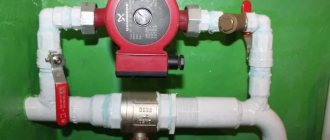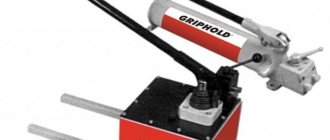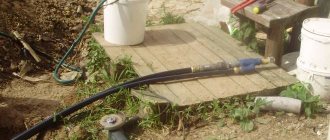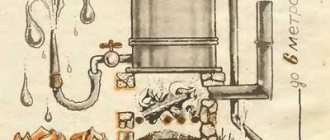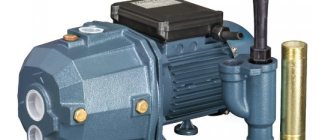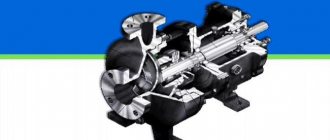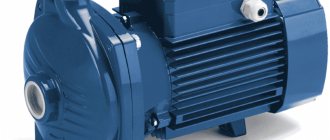Piston pump (plunger pump) and its features:
A piston pump (plunger pump) is a positive displacement pump that uses a piston or plunger to move fluid through and out of a cylindrical chamber (labour cylinder).
A piston pump (plunger pump) is a reciprocating pump that has internal cavities that expand and contract in a reciprocating (back and forth; up and down) motion rather than a circular (rotational) motion.
A piston pump (plunger pump) is a positive displacement pump that moves gases, liquids or gas-liquid mixtures using the reciprocating movements of a piston or plunger in a working cylinder due to a drive.
A piston pump (plunger pump) is one of the first types of pumps invented by mankind.
The peculiarity of this pump is that, unlike many other positive displacement pumps, piston (plunger) pumps are not reversible, that is, they cannot work as hydraulic motors due to the presence of a valve distribution system.
The piston pump (plunger pump) is characterized by its simplicity of design and the ability to work with various working media, incl. with viscous liquids, suspensions and liquids with solid inclusions, due to the creation of high pressures.
Piston (plunger) pumps can be driven manually or by an electric motor, steam engine, pneumatic or hydraulic drive.
The difference between a piston pump and a plunger pump is that it is used as a working element: a piston or a plunger. The piston is cylindrical part A plunger (from the English plunge - “dive, plunge”) is a cylindrical displacer or piston, the length of which is much greater than the diameter. In a piston mechanism, unlike a plunger mechanism, the seal is located on the cylindrical surface of the piston, usually in the form of one or more piston rings. In a plunger mechanism, unlike a piston, the seal is located on the cylinder and when the plunger performs a reciprocating motion, it moves along the surface of the plunger.
Piston (plunger) pumps are made of various materials: cast iron, steel and alloys, bronze, brass, nickel alloys, aluminum , ceramics, plastics , etc. The choice of housing and working cylinder material depends on the specific application. In any case, they must have sufficient strength and also withstand operating conditions. Materials in contact with the pumped medium (piston, plunger, outlet valves and suction valves, internal surface of the working chamber) must be resistant to any corrosion caused by the liquid, chemical attack of the working environment, abrasion resistance, high tensile strength, durability.
Areas of application
The scope of application of piston-type liquid pumps is quite wide, which is explained by their high versatility. Meanwhile, the design of such machines does not allow their use in cases where it is necessary to pump significant volumes of water or other liquid. One of the main advantages of these hydraulic machines is that their pistons, displacing liquid through the discharge line, simultaneously suck in a new portion of it through the supply channel, which is very important in dry cylinder conditions. This quality determines the purpose of piston liquid pumps as the most efficient devices used in chemical industry enterprises.
Hydraulic piston pump for truck crane
The scope of application of piston-type liquid pumps is also expanding due to the fact that such equipment can be successfully used to work with chemically aggressive media, certain types of fuel and explosive mixtures. Pumps of this type are also widely used for domestic purposes; with their help, it is possible to create pipeline systems for autonomous water supply to private buildings and for irrigation. Meanwhile, if you decide to use such a device, do not forget that it is not intended for pumping large volumes of liquid.
Another area in which piston-type liquid pumps are actively used is the food industry. This is explained by the fact that such devices are distinguished by a very delicate attitude towards the liquid pumped through them.
Advantages, disadvantages and applications of piston (plunger) pumps:
The main advantages of piston (plunger) pumps:
- reliability and durability of the structure with timely maintenance;
- high maintainability;
- high service life;
- availability of “dry” suction;
- work in a wide pressure range;
- the ability to create very high pressures (1000 atmospheres or more);
- the ability to regulate the pressure of the working medium without affecting the speed of flow/movement (consumption) of the working medium;
- changes in the pressure of the working medium and the flow rate/movement (flow rate) of the working medium have little effect on the performance of the pump;
- work with various working environments, incl. with viscous liquids, suspensions, abrasive liquids and liquids with solids (in this case the pump is made of high-strength materials).
, piston (plunger) pumps are used in water supply systems, in the food and chemical industries, and in everyday life. Piston (plunger) pumps have been used since ancient times.
At the same time, the pump is not without its drawbacks. It is characterized by:
- low productivity;
- pulsed rate of work and pumping of the working medium. The liquid moves through the pipeline at different speeds (jumps);
- the presence of rubbing parts and assemblies ;
- high operating costs;
- the presence of oil in parts and assemblies in the internal structure of the pump;
- ingress and contamination of the pumped working medium with oils;
- the need to use seals in the pump design.
The main and significant disadvantage of this type of pump is pulsation. Pulsations can be reduced by placing several pistons (plungers) in a row and connecting them to one shaft so that their operating cycles are shifted in phase relative to each other at equal angles. Another way to combat pulsation is to use a differential pump activation circuit, in which the working medium is pumped not only during the forward stroke of the piston, but also during the reverse stroke.
Double acting models
The appearance of this type of piston pump is due to the desire of manufacturers to eliminate the pulsation effect, which occurs precisely because of the rhythm in which the piston pushes out portions of liquid. In such pumps, the rod and piston cavities have individual valve systems. This principle of water supply distribution allows not only to eliminate pulsation, but also to increase productivity. True, one-way liquid piston pumps still have their advantages, which are expressed in a higher degree of reliability and durability. Another modification that was supposed to eliminate the rhythmic supply of fluid is a pump supplemented with a hydraulic accumulator. At the moment of peak pressure, such units collect energy, and when it decreases, on the contrary, they release it. However, it is not always possible to completely eliminate pulsation and operating companies have to appropriately develop liquid intake configurations outside the pump design.
Design and device of a piston (plunger) pump:
Piston pumps and plunger pumps can be differentiated by design based on type, pump action, and number of cylinders.
The simplest design of a piston (plunger) pump consists of a reciprocating mechanism, including a piston (plunger), connecting rod and crank, a working cylinder (body, working chamber, cylindrical chamber), two valves (input and output) and a drive.
The piston (plunger) is made of durable material compatible with the pumped medium, and is hermetically connected or adjacent to the walls of the chamber (working cylinder) using seals. The volume of the working chamber is slightly larger than the volume of liquid, gas or gas-liquid mixture that the piston can displace in one operating cycle. The inlet and outlet valves are typically spring-loaded ball valves or gate valves made from the same chemical resistant and durable material as the piston (plunger). The inlet valve lets the working medium into the working chamber, and the outlet valve releases it.
The drive serves to drive the piston (plunger), connected through a crank mechanism, into reciprocating motion. In this case, the working mechanism of the drive itself can be different: lever, pneumatic, steam, hydraulic or electric.
Literature
- Hydraulics, hydraulic machines and hydraulic drives: Textbook for mechanical engineering universities / T. M. Bashta, S. S. Rudnev, B. B. Nekrasov and others - 2nd ed., revised. – M.: Mechanical Engineering, 1982.
- Geyer V. G., Dulin V. S., Zarya A. N. Hydraulics and hydraulic drive: Textbook for universities. – 3rd ed., revised. and additional – M.: Nedra, 1991.
This type of pump is one of the most ancient. Mechanical displacement of a liquid medium can be called the simplest implementation of the pumping principle. Nowadays, the designs of such units, of course, have a more complex structure compared to the first representatives of the class. In its modern form, a piston liquid pump has a durable housing, a developed element base and provides ample opportunities for communication. The latter aspect determines the distribution of equipment in various areas from domestic needs to highly specialized industrial sectors.
Operating principle of a piston (plunger) pump:
Operating principle using the example of a one-way pump with one cylinder (plunger):
- After the pump starts, the piston (plunger) begins to periodically move up and down a certain distance inside the cylinder using a connecting rod.
- When the piston is retracted by the connecting rod, a vacuum is created in the cylinder, due to which the valve located at the suction port opens, through which the working medium begins to flow.
- When the piston moves in the opposite direction, on the contrary, the suction valve closes, and the one related to the discharge port opens, which subsequently facilitates the exit of the working medium through it.
Types and types of piston (plunger) pumps:
There are two main types of piston pumps: lift pump and power pump.
Piston pump for lifting . In a lift pump, the upward stroke of the piston draws water (or other fluid) through a valve into the bottom of the working cylinder. As it moves downwards, the water passes through valves installed in the piston and into the top of the working cylinder. On the next upward stroke, water is drained from the top of the working cylinder through the spout. This type of pump is limited by the height of water that can be supported by air pressure against vacuum.
In a piston power pump, when the piston moves upward, water (or other liquid) enters the working cylinder through the inlet valve. When draining, the water is discharged through the outlet valve into the outlet pipe.
Piston (plunger) pumps are classified according to:
– pressure:
- low pressure - up to 0.2 MPa,
- average - from 0.2 to 0.6 MPa,
- high pressure - more than 0.6 MPa;
– speed factor ns:
- slow-moving,
- normal,
- high-speed;
– functional purpose (plumbing, household, etc.);
– the number of working cylinders in the pump;
– according to the operating principle of the pump:
- single-acting pumps (have one valve at each end, where suction and discharge occur in opposite directions),
- Double acting pumps (use two valves at each end, allowing suction and discharge in both directions).
Analysis of the problem
To what height can water be raised with a conventional piston pump at normal atmospheric pressure?
It is important to understand that it is not we who drag the water up, but atmospheric pressure that pushes the liquid . By lifting the piston with our hands, we create an airless space, which causes the pressure outside the piston to increase and push out the liquid.
And just as a person cannot lift a truck with his hands, atmospheric pressure is not infinite and will raise a column of liquid of a certain height.
The liquid will rise as long as its pressure is less than atmospheric. That is, when the pressure of the liquid column is equal to atmospheric pressure, the height of the column will be greatest.
$$p=\rho gh$$
- $p$ – pressure of the liquid column and the value of normal atmospheric pressure (760 mm Hg or 101,300 Pa)
- $\rho$ – water density ($997 \frac{kg}{m^3}$)
- $g$ is the acceleration of free fall.
Let's express the height $h$ from this formula:
$h=\frac{p}{\rho g}=\frac{101300 Pa}{997\frac{kg}{m^3} \cdot 9.8 \frac{N}{kg}}≈10.4 m$
In the same way, we can calculate the maximum lifting height for other liquids if we know their density.

